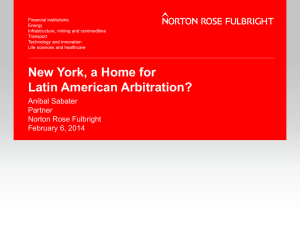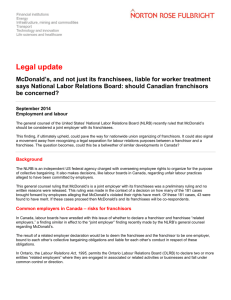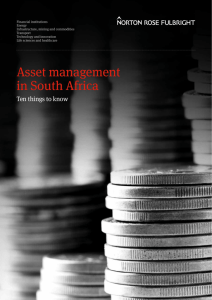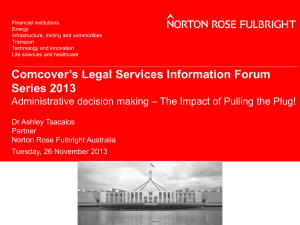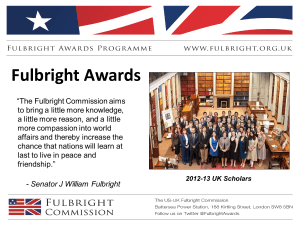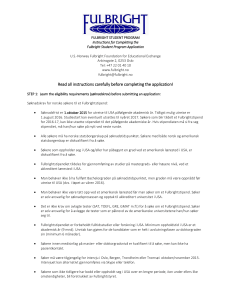Liability Schemes in Sourcing Contracts
advertisement
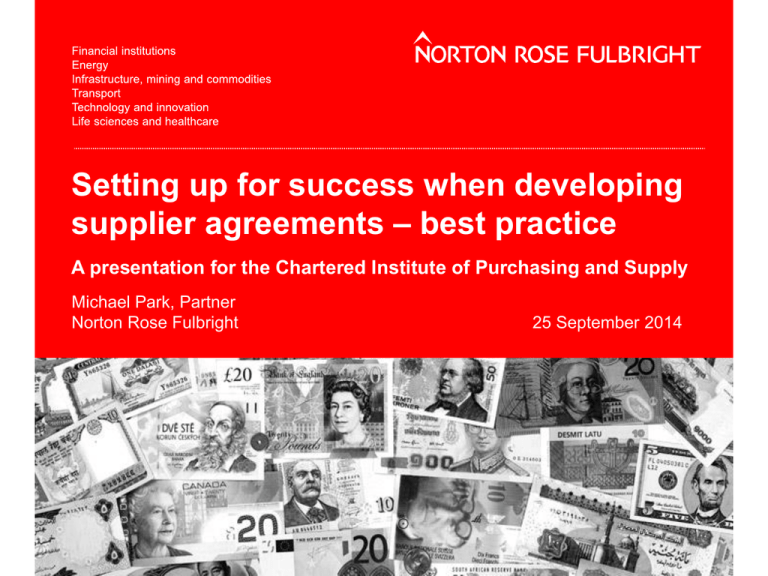
Setting up for success when developing supplier agreements – best practice A presentation for the Chartered Institute of Purchasing and Supply Michael Park, Partner Norton Rose Fulbright 25 September 2014 A smart approach to sourcing • Global survey of sourcing vendors and customers • Customer spend totalling US$13 billion per year • Vendors interviewed comprised a mix of on and off-shore providers • Across all industry sectors • Our findings highlighted the need to – place procurement at the core of corporate strategy – strengthen vendor-customer relationships – adopt a more sophisticated approach to risk 2 The contract • 13% of customers had no procedures in place to ensure final contract reflected business requirements • 44% had only ad hoc procedures • Inadequate time allowed for a full contact review before execution • If contracts are not aligned with business requirements this could lead to operational problems for customers and vendors • Customers need to invest more resources to ensure their contracts are fit for purpose Customer interviewees: customer procedures for ensuring contracts are aligned with business cases Best practice: drafting the contract • One size cannot fit all – contract should reflect business requirements • Project team should be involved in contract preparation, not just Legal • Extensive initial planning, with early input from Legal, is critical • Allow enough time to assess whether contract meets business requirements and is satisfactory from a risk perspective • Consider whether a joint steering committee would be beneficial • Ensure empowered decision makers are at the negotiation coalface – otherwise retracted concessions and delay Procurement risks • Mismatch between vendors and customers as to how they rate and evaluate procurement risks • Suggests that vendors do not fully understand their customers’ business and motivations Vendor views on customer procurement/ project risks Customer views on customer procurement/ project risks Best practice: evaluating risk • Evaluate risk at the outset before issuing the request for tender • Consider allocating a risk manager to the project team • Maintain a written risk register – rank risks as high/medium/low – consider their likelihood of occurrence • Mark the register with details of operational and contractual steps taken to mitigate risk – consider sharing all or part of the risk register with vendors The allocation of risk • Industry sectors demonstrated different approaches to allocation of risk • Customers should adopt a realistic approach – there are some risks that cannot simply be “outsourced” to vendors • But, across all industry sectors, customers had a greater appetite for management of risks than vendors gave customers credit for Best practice: allocating risk • Consider which party can best manage risk – take a realistic view • Focus on risk which is real and important – what are the showstoppers? • View risk holistically – do not focus on a deal breaking position if the overall risk profile of the arrangement is low • Remember risk will be priced Risk management strategies • Having an effective contract was the most popular risk mitigation tool for both customers and vendors • Interestingly, customers showed a greater degree of confidence in the effectiveness of risk mitigation tools than vendors Risk mitigation strategy: consolidated customer view Best practice: managing risk • Consider how risk can be managed and the most appropriate tools • Typically the contract is the key tool for managing risk Key contractual clauses • Liability and indemnities – escalate early if required, steering committee? (see Liability Schemes in Sourcing Contracts) • Change of law – who is responsible and at what cost? • Step in rights – right for competitor to step in • Termination rights – limiting right of service provider to terminate • Data security and privacy – appropriate standards, cross-border privacy • Transition in and out – agree plans and costs up front • Change management – agree an objective procedure up front, two tier? • Dispute resolution – venue for disputes, governing law • Above-country vs in-country arrangements Capturing innovation • 54% of customers expected to own the intellectual property rights in bespoke technology – that is, developed specifically for the customer • But 66% of customers had no systems in place to identify such IP rights – therefore they were not in a position to exploit their assets fully – no able to maximise revenue generating possibilities • Customers should put in place systems to identify and protect IP rights – otherwise they are potentially wasting money acquiring rights Best practice: capturing innovation • Identify the type of rights that are likely to be developed • Assess the importance of these rights to the business – decide whether they should be owned or licensed • Note there is often a significant difference in price between ownership and licensing – is ownership really necessary? – consider scope of any licence required (egg extend to related bodies corporate) • Put in place systems for identifying and protecting these rights Managing performance • Both customers and vendors said the most effective tools for managing vendor performance were – Project management – Key Performance Indicators – Service Level Agreements • Service credits, audit rights and technology did not score highly among either vendors or customers • 87% of customers sought to resolve problems at a relationship level • If disputes are resolved in arbitration or litigation, the project has failed – better to resolve disputes at the working level well before this point Performance management tools Consolidated vendor view Consolidated customer view Best practice: managing performance • Maintain a good, open relationship with your vendor • Decide which performance management tools are best suited to the project – do not over-engineer as this will affect price • Consider a joint governance model, ie a true partnering approach • Regular scheduled meetings of operational teams will ensure problems are quickly identified and escalated internally up the management chain • Binding expert determination may be suitable to resolve deadlocks – especially for disputes over technical subject matter • Set realistic service levels and service credits that drive positive behaviour – carrot and stick approach – balancing service levels and pricing Summary: Project failure and the keys to avoiding it • Rethink the approach to vendor/customer relationships and risk management • There are two broad causes of project failure – inadequate planning and stakeholder review of risks – inadequate negotiation strategy • Always look to achieve extensive initial planning, goal setting, risk analysis and stakeholder buy-in to reduce the risk of failure • Regular review and refresh of this planning phase is critical in keeping the project on time and on budget • Be realistic in setting goals – they should drive positive behaviour for both parties Managing difficult relationships – dispute resolution A presentation for the Chartered Institute of Purchasing and Supply Nigel Jones, Partner Norton Rose Fulbright 25 September 2014 Tips to avoid disputes and deal with them effectively • Relationship management and troubleshooting • The Contract • Evidence and Paper-Trails • Dispute Resolution Mechanisms Relationship Management and Troubleshooting • Early resolution – nipping in the bud early. • Maintain open lines of communication – respectful and constructive – firm but fair. • Flexibility in resolution options (where necessary) – maintain open mind – look for win/win outcomes and sometimes creativity. • Spot tell-tale signs of trouble early: • Failure to meet KPIs, service levels, benchmarks etc. • Non-responsiveness. • And deal with proactively – to avoid escalation. 19 Global best practice in sourcing: how to get the most from your sourcing arrangements The Contract • • • • • • • Fundamental to avoiding disputes. Clear and enforceable terms. Able to be located. Executed. Not expired. Appropriate dispute resolution mechanisms. Document management is critical. 20 Global best practice in sourcing: how to get the most from your sourcing arrangements Evidence – The Importance of Paper-Trails • Documents win cases – and resolve disputes. • The contract – as per previous slide. • Clear contemporaneous records of: • KPIs, service levels, benchmarks etc; and • Key dealings – verbal (notes – and confirmed) and in writing. • Properly collated and easily retrievable. • Gives rise to ease of: • Monitoring performance and correcting non-compliance. • Rebuttal of incorrect allegations. • Briefing lawyers for advice and use in dispute resolution. 21 Global best practice in sourcing: how to get the most from your sourcing arrangements Types of Dispute Resolution Mechanisms • Early engagement (face to face meetings) with clear outcomes communicated, agreed and confirmed in writing – process for escalation to senior management if necessary. • Formal settlement conference – with or without lawyers – Mexican stand-off. • Mediation: • The process - Highly effective. • Preparation: understand facts, strengths, weaknesses and possible outcomes. • Quality mediator. • Flexibility to resolution – be prepared to compromise. • Reaching agreement on the day? • Getting a result that you can live with. • Court determination: • Use litigation to achieve strategic objective. • Evidence preparation – paper-trail – mediation as part of process. 22 Global best practice in sourcing: how to get the most from your sourcing arrangements Types of Dispute Resolution Mechanisms (Cont) • Binding determination (non-Court): • Arbitration or expert determination – intent is quicker, cheaper, technical expertise. • Build dispute resolution mechanisms into the Contract. 23 Global best practice in sourcing: how to get the most from your sourcing arrangements Additional resources Outsourcing in a Brave New World: An international survey of current outsourcing practice and trends http://www.nortonrosefulbright.com/files/outsourcing-in-a-brave-new-world-57727.pdf Liability Schemes in Sourcing Contracts: A global perspective http://www.nortonrosefulbright.com/files/liability-schemes-in-sourcing-contracts-118907.pdf Cloud Computing: A practical guide to legal risks and issues http://www.nortonrosefulbright.com/files/cloud-computing-brochure-103886.pdf Data Centres Unboxed: A guide to legal issues, trends and risks http://www.nortonrosefulbright.com/files/data-centres-unboxed-70745.pdf Global Data Privacy Directory http://www.nortonrosefulbright.com/files/global-data-privacy-directory-52687.pdf 24 Contacts Michael Park Partner & Asia Pacific Technology Business Group Leader Norton Rose Fulbright Direct: +61 3 8686 6499 Mobile: +61 419 049 811 Email: michael.park@nortonrosefulbright.com Nigel Jones Partner Norton Rose Fulbright Direct: +61 3 8686 6931 Mobile: +61 408 035 723 Email: nigel.jones@nortonrosefulbright.com 25 Disclaimer Norton Rose Fulbright LLP, Norton Rose Fulbright Australia, Norton Rose Fulbright Canada LLP, Norton Rose Fulbright South Africa (incorporated as Denys Reitz Inc.) and Fulbright & Jaworski L.L.P., each of which is a separate legal entity, are members (“the Norton Rose Fulbright members”) of Norton Rose Fulbright Vereen, a Swiss Vereen. Norton Rose Fulbright Vereen helps coordinate the activities of the Norton Rose Fulbright members but does not itself provide legal services to clients. References to “Norton Rose Fulbright”, “the law firm”, and “legal practice” are to one or more of the Norton Rose Fulbright members or to one of their respective affiliates (together “Norton Rose Fulbright entity/entities”). No individual who is a member, partner, shareholder, director, employee or consultant of, in or to any Norton Rose Fulbright entity (whether or not such individual is described as a “partner”) accepts or assumes responsibility, or has any liability, to any person in respect of this presentation. Any reference to a partner or director is to a member, employee or consultant with equivalent standing and qualifications of the relevant Norton Rose Fulbright entity. The purpose of this presentation is to provide information as to developments in the law. It does not contain a full analysis of the law nor does it constitute an opinion of any Norton Rose Fulbright entity on the points of law discussed. You must take specific legal advice on any particular matter which concerns you. If you require any advice or further information, please speak to your usual contact at Norton Rose Fulbright.
